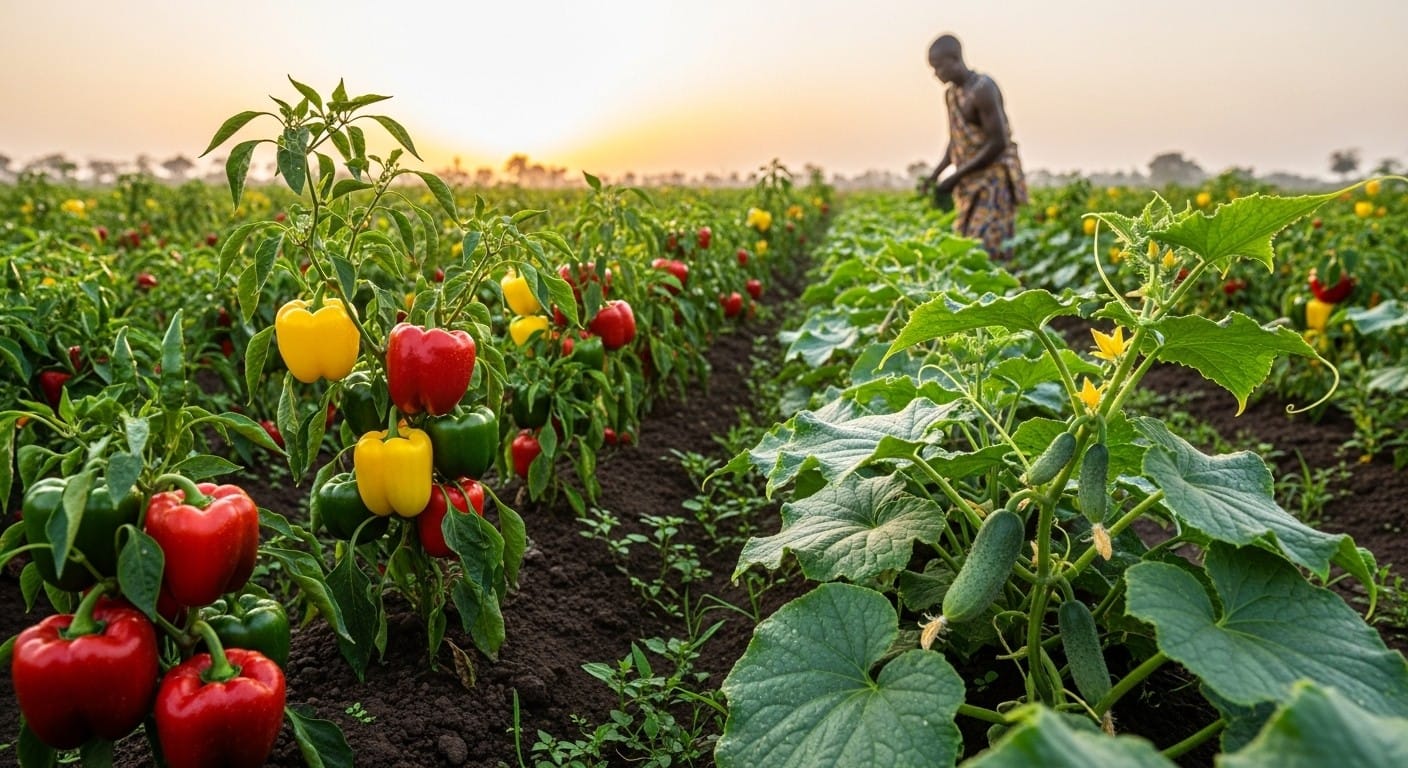Profitable Pepper Farming in Ghana: The Entrepreneur’s Complete Step-by-Step Guide
Ghana’s fertile soil and favorable climate present a golden opportunity for agricultural entrepreneurs. Among the most lucrative ventures is pepper farming, driven by high domestic and international demand. Peppers are a staple in Ghanaian cuisine and a thriving export commodity. For any aspiring entrepreneur, understanding the path from seed to market is crucial. This complete step-by-step guide for entrepreneurs covers everything you need to know about how to start a profitable pepper farming business in Ghana, from best practices in irrigation to selecting high-yield varieties.
Step 1: Conduct Thorough Research and Planning
Before breaking ground, a solid plan is essential. Your success begins with comprehensive research and a detailed pepper farm business plan. This initial phase should cover:
- Market Analysis: Understand the demand for different pepper types. While local markets have a high demand for spicy varieties, the export market (including the US, UK, and Netherlands) may prefer peppers with a longer shelf life and specific appearances.
- Feasibility Study: Assess the viability of your venture. Key considerations include land availability and cost, access to a reliable water source for irrigation, transportation logistics, and the availability of agricultural support services like extension officers.
- Financial Planning: Develop a detailed budget. Estimate your initial investment costs (land, seeds, infrastructure) and ongoing operational costs (fertilizer, labor, irrigation, pest control). Create a sales forecast based on expected yields and market prices to project your revenue and profitability.
Step 2: Acquire Suitable Land and Prepare the Soil
The foundation of a healthy pepper farm is the land itself. Look for land with well-drained loamy or sandy soil. Avoid waterlogged areas, as excessive moisture can lead to root diseases and stunted growth.
Once you have secured land, soil preparation is the next critical task:
- Clear the Land: Remove all weeds, rocks, and debris from the plot.
- Test the Soil: Conduct a soil test to understand its pH and nutrient composition. This will inform you about the necessary amendments.
- Plough and Harrow: Till the soil to loosen it, improve aeration, and create a fine seedbed for optimal root development. For larger farms, using a tractor with a rotavator is efficient.
- Create Beds or Ridges: Prepare raised beds or ridges. This improves drainage and is essential for healthy plant growth, especially during the rainy season.
Step 3: Choose High-Yield and Market-Appropriate Pepper Varieties
Selecting the right pepper variety is a decision that directly impacts your yield, pest resistance, and profitability. Your choice should be guided by your target market (local vs. export) and local growing conditions. A study on pest susceptibility in Ghana provides valuable insights into variety performance.
Popular and High-Yield Pepper Varieties in Ghana
| Pepper Variety | Key Characteristics | Pest Susceptibility (to T. leucotreta) | Best For |
|---|---|---|---|
| Bird’s Eye Chili | Small, very hot, and popular in local and export markets. Good for drying. | Low (Least Susceptible) – A resilient choice for pest management. | Local consumption, export, processing into flakes/powder. |
| Scotch Bonnet | Distinctive flavour and high heat. Highly sought after in Caribbean and international cuisines. | High (Most Susceptible) – Requires robust pest management. | Export, local high-end markets, sauce production. |
| Cayenne | Long, thin, and moderately hot. Often used for drying and making pepper powder. | High (Most Susceptible) – Needs careful monitoring for pests. | Processing, local markets, culinary use. |
| Habanero | Extremely hot with a citrus-like flavour. A premium variety with high market value. | Similar heat and profile to Scotch Bonnet, likely susceptible. | Niche export markets, hot sauce production. |
| Green Pepper (Bell Pepper) | Sweet, not spicy. Harvested green for a longer shelf life and crisp texture. Considered very profitable. | Moderate to High – Sweet pepper was a preferred oviposition site in tests. | Supermarkets, hotels, restaurants, export. |
| KA2 | A locally developed variety known for good yield. | Moderate susceptibility. | General local and regional markets. |
Step 4: Source High-Quality Seeds or Seedlings
Your yield potential is locked within the quality of your planting material. Always source certified seeds or healthy, disease-free seedlings from reputable suppliers, nurseries, or research institutions like the Crop Research Institute (CRI). Avoid using seeds from the previous harvest (recycled seeds), as this often leads to lower yields and increased disease vulnerability.
Step 5: Planting, Spacing, and Crop Care
Proper planting technique ensures your plants get the best start. The ideal time for planting is the beginning of the rainy season to leverage natural moisture, but with effective irrigation, you can farm all year round.
- Nursery Management: If starting from seeds, raise them in a well-managed nursery for about 4-6 weeks before transplanting.
- Transplanting: Transplant seedlings to the main field, preferably in the cool of the late afternoon to reduce transplant shock. Plant them at the same depth as they were in the nursery.
- Spacing: Proper spacing is crucial for air circulation and preventing the spread of disease. A common spacing is 18-24 inches between rows and 12-18 inches between plants.
- Fertilization: Peppers are heavy feeders. Implement a regular fertilization program based on your soil test results. Use a combination of basal compost/manure and follow up with NPK fertilizers to support vegetative growth and fruit development.
Step 6: Implement Efficient Irrigation Practices
Water is life for your pepper farm, especially during the dry season. An efficient irrigation system is non-negotiable for commercial success. Depending on your budget and farm size, consider these options:
- Drip Irrigation: This is the most efficient method. It delivers water directly to the plant’s root zone, minimizing water waste through evaporation and reducing weed growth. It’s an excellent investment for maximizing yield per drop of water.
- Sprinkler Irrigation: Suitable for larger farms, but can be less water-efficient and may increase the risk of fungal diseases if leaves remain wet for extended periods.
- Budget-Friendly Methods: For small-scale farmers, simple gravity-fed systems or manual watering can be effective, but require more labor.
The success of irrigation projects like those at Tono and Vea in the Upper East Region demonstrates the massive potential of all-year-round farming. Consistent water supply ensures continuous production and higher income.
Step 7: Pest and Disease Management
Protecting your crop is key to protecting your profit. Pests like aphids, whiteflies, and the fruit borer (*Thaumatotibia leucotreta*), along with diseases like bacterial wilt and powdery mildew, can devastate a harvest.
Integrated Pest Management (IPM) Strategy:
- Resistant Varieties: Start with varieties that show natural resistance, like Bird’s Eye Chili.
- Cultural Practices: Implement crop rotation, maintain proper plant spacing for airflow, and remove weeds that can host pests.
- Sanitation: Regularly remove and destroy any infected plant material to prevent diseases from spreading.
- Scouting: Monitor your farm regularly to detect pest and disease outbreaks early.
- Chemical Control: Use appropriate and approved pesticides or fungicides only when necessary, following expert advice to avoid harming beneficial insects and the environment.
Step 8: Harvesting and Post-Harvest Handling
Harvesting at the right time and handling the produce correctly ensures you get the best price. The harvesting stage depends on the variety and market demand.
- Timing: Green peppers are picked before they change color for longer shelf life. For other varieties, harvest when they reach their desired color (e.g., red, yellow).
- Method: Use sharp shears or a knife to cut the peppers from the plant, leaving a small stem attached. Avoid pulling the fruits to prevent damaging the plant.
- Handling: Handle harvested peppers with care to prevent bruising. Sort them by size, color, and quality, discarding any damaged ones.
- Storage: Pack the peppers in clean, ventilated crates and store them in a cool, dry place away from direct sunlight to prolong freshness.
Step 9: Marketing, Sales, and Profitability
Growing peppers is only half the battle; selling them profitably is the goal. For an entrepreneur, a strong marketing plan for their pepper farming venture in Ghana is crucial, integrating best practices and focusing on high-yield varieties to attract buyers.
Marketing Channels:
- Local Markets & Consumers: Sell directly at farmers’ markets.
- Hotels & Restaurants: Establish supply contracts with businesses in the hospitality industry.
- Supermarkets: Target retail chains that require consistent, high-quality produce.
- Exporters: This is a highly lucrative channel, especially for varieties like Scotch Bonnet and green peppers. Ensure you can meet their quality and quantity standards.
- Value Addition: Increase your income by processing peppers into sauces, pickles, or dried spices.
Understanding the Profitability
Research from Ghanaian irrigation schemes provides concrete evidence of the high profitability of pepper farming compared to other crops. A study at the Tono and Vea irrigation sites revealed compelling figures:
| Metric (per hectare) | Pepper Farming | Rice Farming |
|---|---|---|
| Average Yield | 4.286 Metric Tons | 3.088 Metric Tons |
| Average Gross Margin (Profit) | Ghȼ10,316.75 | Ghȼ1,041.06 |
Source: Akolgo, J. A. (2021). Estimating the Productivity and Profitability of Rice and Pepper on Fields of the Irrigation Company Upper Region (ICOUR) in Ghana.
The data clearly shows that pepper farming is nearly 10 times more profitable than rice pepper farming in Ghana the same area, making it a superior investment for entrepreneurs aiming for high returns.
Step 10: Overcoming Challenges and Seeking Support
Pepper farming, while profitable, has its challenges, including unpredictable weather, pests, and market price fluctuations. Successful entrepreneurs stay informed and connected.
- Join Farmer Associations: Collaborate with other farmers to share knowledge, access resources, and gain collective bargaining power.
- Seek Extension Services: Leverage support from the Ministry of Food and Agriculture (MoFA) and research institutions like CSIR for technical advice and access to improved technologies.
- Use Technology: Utilize mobile apps for weather forecasts and market information to make data-driven decisions.
By following this complete step-by-step guide, any entrepreneur can confidently embark on a journey to start a profitable pepper farming venture in Ghana, leveraging the right varieties and best practices for sustainable success. The demand is strong, the profitability is proven, and with careful planning and execution, your pepper farm can become a thriving agribusiness.











